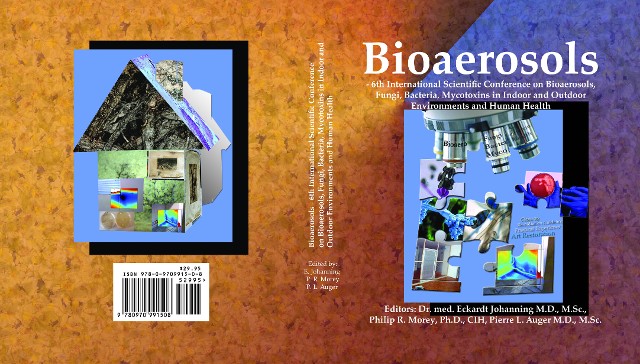
New Book for 2013 with world renowned authors and experts:
Bioaerosols - Fungi, Bacteria, Mycotoxins in Indoor
and Outdoor Environments and Human Health
Editors:
Dr. med. Eckardt Johanning, M.D., M.Sc., Phil Morey, Ph.D., CIH, Pierre Auger,M.D., M.Sc.
Publisher: Fungal Research Group Foundation, Inc., Albany, New York, N.Y.
Library of Congress Control Number: 2012953872 - ISBN: 978-0-9709915-0-8
Special Introductory Price: 19.95 (regular price: $29.95) (391 pages)
email or fax (518 459 4646) your orders now
or call 518 459 3336 (for orders requiring invoice)
Latest International Research and Information regarding Floods and Water Damage related Mold, Bacteria and Mycotoxin Problems
Book Content:
Introduction and Overview 
Since our last meeting in 2003, especially our first meeting in 1993, the body of knowledge regarding indoor and occupadonal microbial exposure (fungi, bacteria and their allergenic, irrirant and toxic by-products) and related diseases with important public health implications has grown significantly. Diseases such as allergy, asthma, inflammatory lung diseases, infections, and cases of mycotoxicosis and neurological or vascular disorders continue
to be associated with exposure to bioaerosols. Complex reacdons and interactions that result in adverse human health reactions pose great challenges to investigators, clinicians and public health officials.
Large scale natural disasters caused be storms and flooding that led to significant water damage and microbial contamination of homes and buildings have occurred in many countries throughout the world: USA, Australia, Pakisran, India, China, England, Poland, Germany, France, Belgium, and elsewhere. In addition to the human tragedy, the costs and technical challenges for cleaning and restoration are tremendous. How do we effectively protect the clean-up workers and the building occupants from harmful microbial conraminants (bacteria, mold, bio-toxins) and exposures?
We have learned that poor building and ventilation designs or maintenance, can contribute to increased microbial indoor exposure. Furthermore, the use of watersensitive materials in areas with hot and humid climates, inadequate resources, as well as deficient renovation of existing architectural designs are factors that can lead ro indoor mold growth. This has raised international concern about the impact of bioaerosols on the building occupants and workers' health.
Climate Change, The Indoor environment, and Health - study summary 
Health Effects – Epidemiological research 
- NIOSH Field Studies on Dampness and Mold and Related Health Effects. by Jean M. Cox-Ganser
- How to find, how to manage? Developing guidelines for mold problems through research. byAino Nevalainen, Martin Taubel, Helena Rintala and Anne Hyvarinen
- Hypersensitivity pneumonitis. byE. Neil Schachter
- Health Complaints, Lung Function, and Immunologic Effects in German Compost Workers from Long-term Exposures to Bioaerosols. by Juergen Bunger, Anja Deckert, Frank Hoffmeyer, Dirk Taeger, Thomas Bruning, Monika Raulf-Heimsoth, Vera van Kampen
- Airborne workplace exposure to microbial metabolites in waste recycling plants. byStefan Mayer, Vinay Vishwanath, Michael Sulyok
- Respiratory Health and Flood Restoration Work in the Post-Katrina Environment. by Roy J. Rando, John J. Lefante, Laurie M. Freyder, Robert N. Jones
- Mold species identified in flooded dwellings. by Denis Charpin
- Attributable fractions of risk factors of respiratory diseases among children in Montreal, Canada. by Louis Jacques, Celine Plante, Sophie Goudreau, Leyla Deger, Michel Fournier, Audrey Smargiassi, Stephane Perron, Robert L. Thivierge
- Fungi and chronic rhinosinusitis (CRS): Cause and effect. by E B Kern, J U Ponikau, D A Sherris and H Kita
- Rhinosinusitis and mold as risk factors for asthma symptoms in occupants of a water-damaged building by Ju-Hyeong Park
- Conclusions on health implications of airborne molds: Analysis of airborne molds in 11 contaminated houses using a new method of evaluation. by Urban Palmgren, Judith Miiller
- Observational Epidemiology and Water Damaged Buildings. by Joseph Q. Jarvis, and Philip R. Morey
- Molds and Mycotoxins: Factors That Affect Exposure and Contribute to Adverse Health Effects. by Karin K. Foarde, Timothy Dean, Doris Betancourt, Jean Kim, Anthony Devine, Grace Byfield, and Marc Menetrez
- Does Reversibility of Neurobehavioral Dysfunction by Monosodium Luminol have Diagnostic and Possible Therapeutic Usc in Mold/Mycotoxin Exposed Patients? by Kaye H. Kilburn
Assessment & remediation 
- Associations between ventilation and mycological parameters in homes of children with respiratory problems. by Hans Schleibinger, Daniel Aubin, Doyun Won, Wenping Yang, DenisGauvin, Pierre Lajoie
- The Penetration of Mold Into Fibrous HVAC Insulation Makes Cleaning Impossible. by Thomas G. Rand and Phil Morey
- Past, Presence and Future of Immunoassays for Mycotoxin Testing. by Erwin Maertlbauer
- Health risks of sur face disinfection in households with special consideration on quaternary ammonium compounds (QACs). by Axel Kramer, Harald Below and Ojan Assadian
- Toxicity study of field samples from water damaged houses in flooded areas in Poland. by Magdalena Twaruiek, Jan Grajewski, Manfred Gareis
- Mycotoxin screening of indoor environments in sentinel health investigations. by Eckardt Johanning and Manfred Gareis.
- A Comparison of two Sampling Media (MEA and DG18) for Environmental Viable Molds. by Sirkku Hakkila
- Evaluation strategy in damp buildings and use of infrared thermography. by Yves Frenette
- Prevalence of mold observations in European housing stock . by Ulla Haverinen-Shaughnessy
- Indoor Molds and Respiratory Hypersensitivity: A Comparison of Selected Molds and House Dust Mite Induced Responses in a Mouse Model. by
Marsha D W Ward, Yongjoo Chung, Lisa B Copeland, Don Doerfler and Stephen Vesper
- What does the development of fungal sys tematics mean to DNA-based methods for indoor mold investigations? by De-Wei Li and ChinS. Yang
- Case study: Determination of moisture damages on items of art in exhibitions by the use of microbial analysis. by Judith Mueller and Urban Palmgren
- Investigation of effectiveness of mold disinfectants and chemicals on total cell numbers of mold on building materials.
Judith Mueller and Urban Palmgren
- Microbiological characterization of aerosols isolated from remote lakes in the Chilean Patagonia. by Escalante G, Leon C, Campos V, Urrutia Rand Mondaca MA.
- Use of Culture and PCR Analysis in Mold Assessments .by Philip R. Morey
- Factors promoting the exposure to bioaerosols among swiss crop workers. by Helene Niculita-Hirzcl and Anne Oppliger
- The investigation of mold occurrence inside selected Durban homes . by Nkala BA, Jafta N and Gqaleni N
- Conserving our cultural heritage: the role of fungi in biodeterioration . by Hanna Szczepanowska and A. Ralph Cavaliere
Prevention, Public Health, Guidelines 
- Risk and Hazard Assessment of Molds Growing Indoors . by Harriet M. Ammann
- Recommendations for detection and remediation of mold growth in indoor environments in Germany. byChristiane Baschien, Hein.z-Jorn Moriske, Kerstin Becker, Marike Kolossa Gehring and Regine Szewzyk
- Indoor water and mold damage - investigation and deconramination practices in Germany. by Wolfgang Lorenz
- Update of Canadian and International Mold Guidelines and Srandards . byDonald M. Weekes
- Defining "Clean" in terms of the unseen fraction: A Representative Marker inSchools. Richard Shaughnessy, Eugene C. Cole, Ulla Haverinen-Shaughnessy.
- Effective risk communication concerning environmental change with communities and patients exposed to excessive indoor moisture or mold. by Paula Schenck and Robert DeBernardo
- Critical Issues in Art Conservation After A Water Intrusion Event: Pitfalls of the Emergency Response. by Karen H. Kahn
Authors 
|
|
